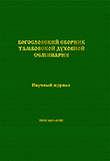Intertextual analysis of parables about the call of the Lord to all humanity
DOI:
https://doi.org/10.51216/2687-072X_2022_1_48Keywords:
Holy Scripture, Gospel parables, God's call to humanity, intertextual connections, patristic exegesis, Old Testament prophecies.Abstract
The article examines the intertextual connections of the gospel parables containing God's call to the human race. It is known that in His sermon Jesus Christ gave examples from everyday life, thereby simplifying the understanding of moral norms to a wide range of listeners. In the gospel parables, Christ revealed the meaning of His coming to earth, and also with the help of allegorical images gave an idea of the Kingdom of God. The author focuses on the parables of those invited to the feast, the lost sheep and the lost drachma, which reveal the image of Christ as the Savior, the features of God's call and people's response to it. The author identifies the places of Holy Scripture, the ideological content of which is similar to the meaning of the parables told by Jesus Christ. The intertextual analysis of parallel passages is based on patristic exegesis and commentary by modern biblical scholars. The novelty of the research lies in the combination of exegetic, comparative and intertextual methods, which allowed the author to identify the peculiarity of the gospel narrative, for which the term «auto-exegesis» is proposed.
Downloads
References
1. Климент (Капалин), митр. Действуй сегодня / митрополит Калужский и Боровский Климент (Капалин). – Москва : Издательство Московской Патриархии Русской Православной Церкви, 2019. – 288 с. – ISBN 978-5-88017-746-2. – Текст : непосредственный.
2. Бахтин, М. М. Эстетика словесного творчества / М. М. Бахтин ; сост. С. Г. Бочаров ; примеч.: С. С. Аверинцев, С. Г. Бочаров. – Москва : Искусство, 1979. – 423 с. – Текст : непосредственный.
3. Корниенко, Е. Р. Текст сквозь призму философии М. М. Бахтина / Е. Р. Корниенко. – Текст : непосредственный // Знание. Понимание. Умение. – 2010. – № 1. – С. 128–133.
4. Каллист (Уэр), еп. Как читать Библию / епископ Каллист (Уэр). – Текст : электронный // Предание.ру : православный портал. – URL: https://predanie.ru/book/67744-kak-chitat-bibliyu/ (дата обращения: 08.11.2020).
REFERENCES
1. Clement (Kapalin), Metropolitan Deistvui segodnya [Act today]. Moscow, Moscow Patriarchate of the Russian Orthodox Church Publ., 2019, 288 p. (In Russian).
2. Bakhtin M.M. Estetika slovesnogo tvorchestva [Aesthetics of verbal creativity]. Moscow, Art Publ., 1979, 423 p. (In Russian).
3. Kornienko E.R. Tekst skvoz’ prizmu filosofii M.M. Bakhtina [Text through the prism of M.M. Bakhtin philosophy]. Znanie. Ponimanie. Umenie. [Knowledge. Understanding. Skills], 2010. no. 1, pp. 128–133. (In Russian).
4. Kallistos (Ware), Bishop Kak chitat’ Bibliyu [How to Read the Bible]. Predanie.ru: pravoslavnyi portal [Predanie.ru: Orthodox portal]. (In Russian). Available at: https://predanie.ru/book/67744-kak-chitat-bibliyu/ (accessed: 08.11.2020).
Downloads
Published
Issue
Section
Categories
License

This work is licensed under a Creative Commons Attribution-ShareAlike 4.0 International License.

